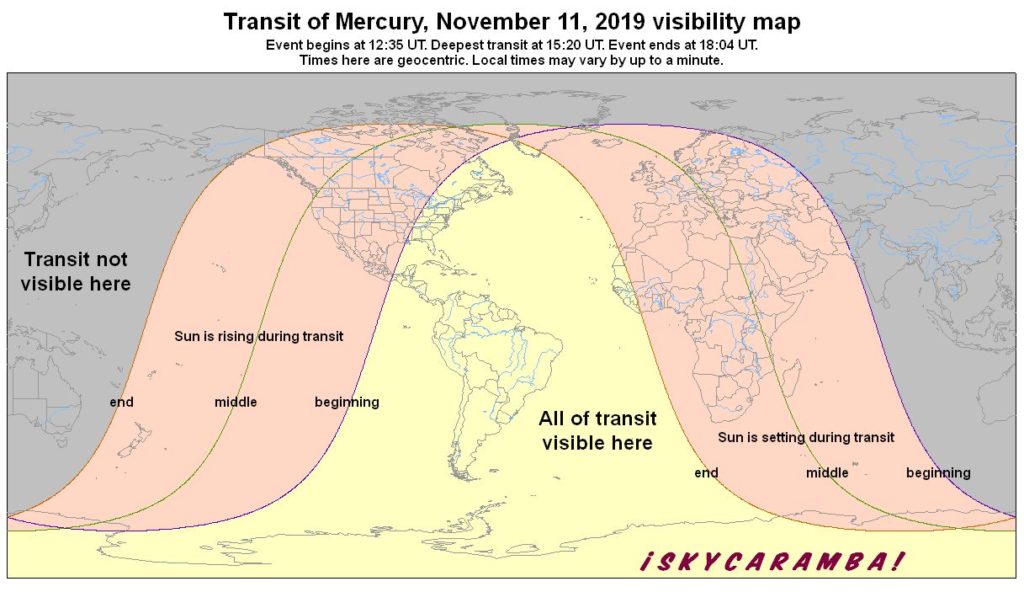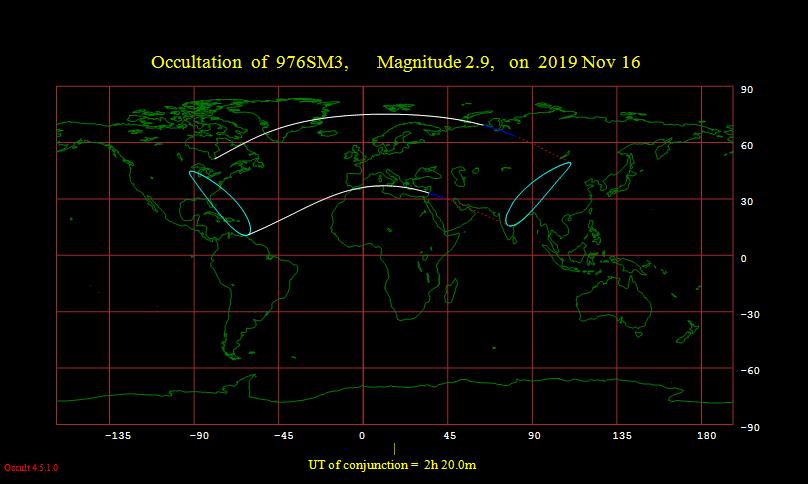November 2019 astronomy
Mercury and Venus are together in the west at sunset when November starts. Jupiter is a bit above them. Saturn is higher still. All four are in the western sky. If you’re looking for the fifth traditional naked eye planet to join them, we’re sorry to disappoint you. Mars is a morning object and will not join the rest this month.

If you’re lucky, you may see Uranus rising right after sunset, although Mercury and Venus may set before the sky is dark enough to see Uranus with the naked eye. Not usually counted as a naked eye planet, Uranus actually is slightly brighter than 6th magnitude, which is considered the cutoff.
For approximately 40 minutes on November 9, Jupiter will be visible from Earth without any of the Galilean satellites next to it. While Io and Ganymede transit the planet’s disk, Europa will be behind the planet and Callisto will be in Jupiter’s shadow. It is uncommon to see Jupiter “without satellites”. The last time it happened was in 2009. In the first book of his Mathematical Astronomy Morsels series, mathematician and astronomer Jean Meeus found the 2009 “Jupiter without satellites” event would be the 23rd since 1907.

Because Jupiter is just 40° east of the sun for the 2019 event, there won’t be many places on Earth where it’s visible. For almost everyone, the event will happen during daylight hours or at night after Jupiter has set. You have a better chance of observing some of the other satellite events leading up to and happening after it.
Here’s a timeline of the Jupiter events for November 9. Times are approximate and could vary by a few minutes depending on how fast each moon disappears or reappears in your telescope or binoculars.
11:23 – 11:48 Callisto enters Jupiter’s shadow
11:59 – 12:10 Ganymede begins transiting Jupiter
12:06 – 12:11 Europa goes behind the planet
12:14 – 12:17 Io begins transiting Jupiter
12:17 – 12:56 Jupiter is visible without satellites at low magnification
12:56 – 13:29 Callisto emerges from Jupiter’s shadow
13:00 – 15:16 Io’s shadow crosses the planet
14:26 – 14:30 Io’s transit across Jupiter’s disk ends
14:40 – 14:51 Ganymede’s transit ends
15:09 – 18:03 Ganymede’s shadow crosses Jupiter
15:15 – 15:20 Europa emerges from Jupiter’s shadow
Mercury is a tough catch for northern hemisphere viewers at this time. It’s making a hasty retreat sunward toward inferior conjunction on the 11th. The best views will be from low southern latitudes.

This inferior conjunction of Mercury will be special. From 12:35 to 18:04 UT, the planet will transit the sun. A little black dot that is the planet will cross the sun’s face for the first time since 2016 and for the last time until 2032. Observers in Africa and western Europe will see the first part of the transit. Those in South America, most of the Atlantic, and most of the Antarctic will see all of it. The last part is visible from North America and most of the Pacific.
Venus holds on in the evening sky as Jupiter moves toward the sun. The two planets are close around the 24th. They are on one side of the Sagittarius teapot while Saturn is on the other. By the 30th, Sagittarius is setting as dusk gives way to night’s darkness. Jupiter is positioned a little differently, but it is still on the west side of the teapot lid. Venus is right on top. Saturn remains on the east side. Keep watching this scene. Around December 10, Saturn and Venus will be paired.

Mars is a morning object in Virgo. See it passing within 3° of Spica on the 10th. By the end of the month, Mercury has become a morning object in the area.
Some lunar events this month:
2nd – lunistice 23° south
4th – first quarter
7th – apogee 405,100 km
9th – goes north of equator
12th – full moon
16th – lunistice 23.2° north
19th – last quarter moon
23rd – goes south of equator
23rd – perigee 366,700 km
26th – new moon
29th – lunistice 23.2° south
Mercury is at perihelion on the 16th at 0.307 astronomical units from the sun. Venus is at aphelion at 0.73 au on the 28th.
Also on the 28th, Mercury is at greatest elongation, 20.1° west of the sun in the morning sky.
Some notable conjunctions this month
2nd – Saturn-moon 0.6°
10th – Venus-Antares 3.9°
10th – Mars-Spica 2.8°
11th – Mercury-sun 0.0° inferior conjunction and transit of Mercury
14th – Moon-Aldebaran 3.0°
17th – Moon-Pollux 5.4°
20th – Moon-Regulus 3.5°
23rd – Moon-Spica 7.0°
24th – Mars-Moon 4.0°
24th – Jupiter-Venus 1.4°
25th – Mercury-Moon 1.8°
27th- Moon-antares 7.0°
28th – Moon-Venus 1.9°
29th – Saturn-moon 0.9°

For some viewers in the far south seas, the moon will pass in front of Saturn on November 2.

The moon will pass in front of the star Tejat in Gemini on November 16. The event will be visible from Europe and the northern Atlantic Ocean.
